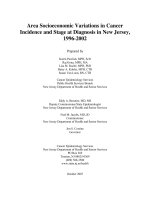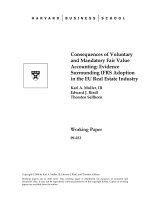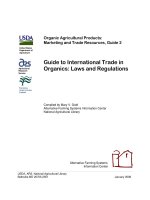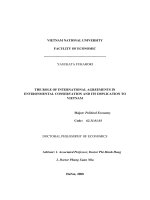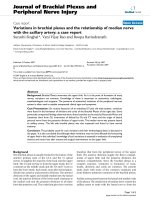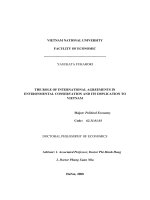International variations in ifrs adoption and
Bạn đang xem bản rút gọn của tài liệu. Xem và tải ngay bản đầy đủ của tài liệu tại đây (1.44 MB, 44 trang )
Research report 124
International Variations in
IFRS Adoption and Practice
International Variations in
IFRS Adoption and Practice
Professor Christopher Nobes
Royal Holloway, University of London
Certified Accountants Educational Trust (London), 2011
ACCA’s international research programme generates high-profile, high-quality, cutting-edge research. All research
reports from this programme are subject to a rigorous peer-review process, and are independently reviewed by two
experts of international standing, one academic and one professional in practice.
The Council of the Association of Chartered Certified Accountants consider this study to be a worthwhile contribution to
discussion but do not necessarily share the views expressed, which are those of the author alone. No responsibility for
loss occasioned to any person acting or refraining from acting as a result of any material in this publication can be
accepted by the author or publisher. Published by Certified Accountants Educational Trust for the Association of
Chartered Certified Accountants, 29 Lincoln’s Inn Fields, London WC2A 3EE.
ISBN: 978-1-85908-473-1
© The Association of Chartered Certified Accountants, 2011
Contents
Abbreviations
4
Executive summary
5
1. Introduction
7
2. International differences before IFRS
9
3. Grouping countries and accounting systems
14
4. How countries react to IFRS
16
5. Different national patterns of IFRS practice
21
6. National patterns on transition to IFRS
25
7. Have national patterns persisted?
31
8. Country groups and national patterns of IFRS
33
9. Does size matter?
35
10. Conclusions
36
References
38
INTERNATIONAL VARIATIONS IN IFRS ADOPTION AND PRACTICE
3
Abbreviations
ACCA
Association of Chartered Certified Accountants
AGL
actuarial gains and losses
ASB
Accounting Standards Board
ASX
Australian Stock Exchange index
AVCO
average cost
BRIC
Brazil, Russia, India and China
CAC
French Stock Exchange index
DAX
German Stock Exchange index
DC
dominated culture
EU
European Union
FIFO
first in, first out
FPI
foreign private issuer
FRRP
Financial Reporting Review Panel
FTSE
Financial Times Stock Exchange index
GAAP
generally accepted accounting principles
HGB
Handelsgesetzbuch (German Commercial Code)
IAS
International Accounting Standard
IASB
International Accounting Standards Board
IASC
International Accounting Standards Committee
IBEX
Iberian Stock Exchange index
IFRIC
International Financial Reporting Interpretations Committee
IFRS
International Financial Reporting Standards
JV
joint venture
LIFO
last in, first out
OCI
other comprehensive income
PPE
property, plant and equipment
SCE
statement of changes in equity
SEC
Securities and Exchange Commission
SMEs
small and medium-sized entities (or enterprises)
SORIE
statement of recognised income and expense
SSAP
Statement of Standard Accounting Practice
SSC
self-sufficient financial and legal culture
4
Executive summary
This report is designed to investigate the degree to which
financial reporting remains different, by country, even
within the area of the world that has apparently adopted
International Financial Reporting Standards (IFRS). The
differences between countries can be divided into two
main types: (i) the degree to which IFRS has been
mandated or allowed for particular companies or types of
reporting, and (ii) the degree to which the practice of IFRS
differs along national lines. These two issues are closely
linked because of the underlying forces that have caused
the long-running accounting differences between
countries.
International differences in financial reporting create
problems because many users (eg investment analysts
acting for investors in equity or debt) assess companies on
a comparative basis internationally. Reconciliations from
one set of generally accepted accounting principles (GAAP)
to another (especially to US GAAP) were common until
2007, and they revealed significant differences between
countries. A standard reporting system for listed
companies would address these problems. There would be
disadvantages if the whole world had to adopt US GAAP.
Therefore, IFRS have been developed instead.
A large number of explanations have been offered for
differences in the accounting systems of different
countries. One model (suggested by the author) is that,
unless one country is dominated by another, a national
accounting system will be largely determined by the
predominant type of financing and owners of companies
(and, therefore, by the predominant users of financial
reporting). The model can be used to predict how a
country’s (or a company’s) reporting will change as its
corporate financing changes. This is especially relevant for
countries in transition from Communism. In addition, it is
now clear that one country (and even one company) can
use more than one system simultaneously for different
purposes.
This report shows that each accounting system can be
classed as being one of two main types, on the basis of the
differential strength of equity markets. For example, one
type of accounting (IFRS or US GAAP) is needed by large
listed groups for reporting to international investors; the
other type (eg French accounting) is relevant to small
private companies for reporting and tax accounting.
The International Accounting Standards Board (IASB) has
no authority to impose IFRS on companies, and the
reactions of different jurisdictions to IFRS differ greatly.
Some have ignored it, some have allowed it; some have
required IFRS for some purposes, whereas others have
abolished national GAAP in favour of IFRS. Very few
jurisdictions have simply imposed IFRS as issued by the
IASB, although some countries (eg Canada) do incorporate
IFRS into law without amendment. Others make
INTERNATIONAL VARIATIONS IN IFRS ADOPTION AND PRACTICE
amendments and then insert the result into law. All these
methods (apart from simply imposing IFRS) need
continual attention from regulators. Divergences from IFRS
can emerge, not least in the timing of adoption of
amendments and new standards. Auditors do not always
report on compliance with ‘IFRS as issued by the IASB’
even when this is being achieved.
The two-type classification can be used to explain and
predict which countries will allow IFRS for unconsolidated
reports. In Europe, only those with a history of strong
equity markets allow IFRS for this purpose. This is because
such countries have tax accounting that is, for many
topics, separate from financial reporting. Therefore, IFRS
can be used in such countries without upsetting tax
calculations.
Several major countries have not yet moved to IFRS even
for listed companies – Brazil and Canada are adopting
IFRS, at least for listed companies in 2010 and 2011
respectively. It seems unlikely that China or Russia will fully
adopt IFRS in the near future. The US might partially adopt
IFRS for 2014 or later; Japan possibly for 2016.
Some of the factors that led to pre-IFRS international
accounting differences can still influence IFRS practices.
For example, there is still scope for tax influence to feed
through from non-IFRS unconsolidated statements to IFRS
group statements.
There are many opportunities for IFRS practices to differ
from company to company or from country to country. For
example, different versions of IFRS arise because most
countries introduce delays or changes when implementing
IFRS; in addition, there are options within IFRS. For several
reasons, it can be expected that a company will continue
with many of its previous accounting policy choices when
it first adopts IFRS. This report lists 13 policy choices and
makes predictions about which choices would be made
under IFRS in five countries: Australia, France, Germany,
Spain and the UK. The actual policy choices made by large
listed companies in these five countries for 2005 are then
recorded. There is statistically strong evidence that preIFRS national practices have continued. The national
patterns of IFRS practice are set out in order to help users,
preparers and auditors to appreciate the differences and
to compare annual reports.
The policies for the same countries and companies are
examined again in 2008. The report shows that there had
been few policy changes since 2005 and, therefore, the
national patterns remain. One major change did occur
between 2005 and 2008: Continental companies moved
to the UK practice of charging actuarial losses to other
comprehensive income (and, incidentally, they therefore
had to present a statement of such income).
EXECUTIVE SUMMARY
5
A classification of countries by their IFRS practices reveals
the same two-group model (‘Anglo’ versus Continental
European) as seen in earlier classifications of national
practices. The number of IFRS policy changes, from 2005
to 2008, also differs between these two country groupings.
Continental companies changed their policies much more
extensively after the transition to IFRS than did Anglo ones.
No underlying economic justifications could be discerned
for the continuing international differences in IFRS policies.
Taking Germany as an example, this report shows that
small listed companies choose significantly different IFRS
policies from the largest companies. The smaller
companies are more inclined to continue their traditional
practices.
This report recommends that jurisdictions should consider
adopting the IASB’s process rather than producing
national versions of IFRS. If the latter must be done, then
auditors should still be required to give an opinion on
‘IFRS as issued by the IASB’ where that is the intended
result in the jurisdiction. Developing countries with few or
no listed companies should consider carefully whether
IFRS is appropriate for them.
Analysts and others need to be alert to the opportunities
for different practices within IFRS. The report provides
analysts and others with a chart of typical IFRS practices
by country. The report recommends that the IASB should
eliminate most of the available options currently within
IFRS.
There are many opportunities for further research. The
report’s model of the reasons for the development of
different accounting methods in different countries could
be tested for a larger group of countries. Researchers
could also apply, to a wider group of countries, the report’s
method of classifying countries by methods of IFRS
implementation, and they could create a new classification
related to the IFRS for SMEs. There is also room for
investigation of the quality of translations of IFRS and of
the quality of enforcement.
On the matter of the choice of IFRS options by companies,
researchers could extend the study to more countries,
later years and smaller companies. There might also be
ways of studying less obvious variations in IFRS practice,
such as impairment calculations.
6
1. Introduction
1.1 The dangers of poor communication
If most investors had stayed within national boundaries (as
was the case until the 1970s) the use of national
accounting practices would have remained unproblematic.
When stock markets became international, however,
communication went awry. One drastic solution would
have been to make all listed companies use US GAAP.
Reconciliations
That, indeed, was the solution for some purposes. Table
1.1 illustrates this. Until 2007, foreign companies listed on
US exchanges were required by the Securities and
Exchange Commission (SEC) either to present financial
statements using US GAAP or to reconcile numerically
their specific national accounting to US GAAP.
Table 1.1 shows the summary reconciliations of Glaxo’s
shareholders’ equity (= net assets). This number is the
denominator of profitability or gearing ratios. In the first
row of the table, to take an extreme example, those ratios
were about 100 times larger under US GAAP compared
with UK GAAP.
Table 1.1: GlaxoSmithKline reconciliations of shareholders’
equity to US GAAP
UK
IFRS
US
Difference
£m
£m
£m
% change
1995
91
8,168
8,876
1996
1,225
8,153
566
1997
1,843
7,882
328
1998
2,702
8,007
196
1999
3,142
7,230
130
2000
7,517
44,995
+499
2001
7,390
40,107
443
2002
6,581
34,992
432
2003
5,059
34,116
574
2004
5,925
34,042
475
2005
7,570
34,282
353
2006
9,648
34,653
259
The reconciliations enabled Glaxo to be compared with
large US pharmaceutical companies. This improved
decision making, lowered risk for investors and lowered
the cost of capital in the case of UK companies, as other
ACCA reports show (Lee at al. 2008).
In practice, only a very small number of non-US
companies were SEC-registered, and therefore few
provided these reconciliations. Further, for 2007 and after,
the SEC has removed the reconciliation requirement, partly
in order to make US exchanges more attractive to
foreigners. This saved a lot of work for companies such as
Glaxo, but hardly improved the quality of communication:1
it is no longer known how big the differences are.
Why not go the whole way and impose US GAAP?
As noted above, one drastic solution to the communication
problem would be for all listed companies around the
world to use US GAAP. Counter-arguments are:
• US GAAP is too complex for most companies
• US GAAP relies too much on detailed rules rather than
on principles
• US GAAP is ‘wrong’ in some areas (for example, by
allowing last in, first out (LIFO), and by not defining
subsidiaries in terms of actual control)
• US GAAP would be politically unacceptable in many
countries.
International standards
From the 1970s onwards, international standards were
created to solve some of these problems. National habits
are tenacious, however, and it has taken decades for
international standards to become widely used. There are
three aspects of IFRS that remain national.
• Different countries have taken markedly different
approaches to implementing IFRS.
• National versions of IFRS practice have grown up, so
that there is still no internationally uniform practice,
even where IFRS is used without amendments.
• Monitoring and enforcement of IFRS practice remain
the responsibility of national regulators.
This report focuses on the first two items above: different
national implementations of IFRS and different national
versions of IFRS practice.
Source: compiled from the annual reports of GlaxoSmithKline.
1. For example, Ashbaugh and Olsson (2002) show that US GAAP and
IFRS numbers have statistically different properties.
INTERNATIONAL VARIATIONS IN IFRS ADOPTION AND PRACTICE
1. INTRODUCTION
7
Evidence of national or regional quirks (in bold type below)
can be seen in some splendidly oxymoronic phrases in the
report of Glaxo’s auditors on the 2009 statements:
1.2 AIMS OF THIS REPORT
In order to investigate the issues above, this report:
‘we conducted our audit in accordance with International
Standards on Auditing (UK and Ireland)…’
• provides an overview of some of the literature on the
reasons for the differences in accounting practices
‘the group financial statements give a true and fair view,
in accordance with IFRSs as adopted by the European
Union…’
• extends the application of that literature to Brazil,
Russia, India and China (BRIC)
‘the group financial statements have been properly
prepared in accordance with the Companies Act 2006
and Article 4 of the IAS Regulation…’
So, the auditing standards are ‘international’ but also ‘UK
and Ireland’; the accounting standards are ‘international’
but also ‘EU’, and the law requires ‘international
accounting standards’ because of an EU ‘Regulation’ but it
is British as well.
• provides a theory to explain the different ways in which
countries have implemented IFRS
• investigates the motives for different national versions
of IFRS practice
• clarifies the scope for such different versions within
IFRS rules
• investigates whether major listed companies preserved
a national pattern of accounting on transition to IFRS in
2005
• investigates whether any national patterns still persist
by examining 2008/9 financial reports
• applies these findings to economically important
countries that will adopt IFRS in the future.
8
2. International differences before IFRS
2.1 DEFINING SOME TERMS
2.2 A SIMPLE MODEL
One of the problems in identifying reasons for accounting
differences, and then classifying accounting systems into
groups, is a lack of clarity about what is being examined or
classified. This report discusses accounting practices,
using ‘accounting’ to mean published financial reporting.
In some jurisdictions, the rules of financial reporting may
be identical or very similar to the practices, but sometimes
a company may depart from rules or may have to make
choices in the absence of rules. So, it seems more
pertinent to discuss actual practices rather than formal
rules.
The academic literature3 offers a large number of possible
reasons for international differences in accounting. The
explanation can be dramatically simplified by suggesting a
single main factor: how companies are financed. This
factor has two dimensions, as shown in Table 2.1.
Another difficulty concerns the word ‘system’. It sometimes
includes entities such as regulatory agencies, whereas
other uses of the term refer to a corpus of accounting rules
or practices. This report follows the latter usage; that is, an
‘accounting system’ is a set of practices used in a
published annual report. Although this is a narrow
definition, these practices will reflect the wider context in
which that accounting system operates. Yet another issue
is whether to separate disclosure from measurement
practices. It seems appropriate to include the presence or
absence of certain key disclosures (eg earnings per share,
cash flow statements) as elements of an accounting
system.
A further issue is to determine whose accounting practices
are being examined. In general, this report will discuss
listed companies, because their accounting is easy to
inspect and can benefit from international harmonisation.
A related point is that all the researchers2 classify
countries. A country can have more than one system – one
for companies with publicly traded securities and another
for small private companies.
In addition, a country’s accounting system may change
dramatically; for example as a result of economic or
political revolutions (eg China, Russia, Poland). In addition,
accounting in a country can change quite significantly as a
result of new laws (eg in Spain from the late 1980s, as a
consequence of EU Directives). Lastly, companies in two
countries (eg the UK and Ireland) can use extremely
similar accounting practices (ie perhaps the same
‘system’).
The detailed elements of accounting practice can differ so
much from one company to another that the number of
different sets of practices is effectively infinite. A certain
degree of variation among company practices may be
allowed, however, without having to abandon the idea that
the companies are all using the same system.
2. Such as: Nair and Frank (1980); Nobes (1983); Doupnik and Salter
(1993).
INTERNATIONAL VARIATIONS IN IFRS ADOPTION AND PRACTICE
‘Insiders’ are investors (in equity or debt) who have
long-term relationships with the company. They can
appoint board members, or may have special access to
information. Examples are: family members (even in large
listed companies, eg Fiat); banks (as big lenders or as
major equity holders, eg Daimler); and governments (eg
Renault).
By contrast, ‘outsiders’ are the millions of shareholders
who have small percentages of shares or listed debt.
Included in this group are large shareholders (eg pension
funds in the US or UK) as long as they have no privileged
access to company information (because, for example, that
would break insider-dealing laws in the country
concerned).
Examples of the financing systems are as follows.
• System I (credit/insiders) is associated with several
continental European countries in the 19th and 20 th
centuries.
• System II (credit/outsiders) might be rare, but there is
a vast amount of listed debt on the New York Stock
Exchange.
• System III (equity/insiders), elements of which are seen
in Japan.
• System IV (equity/outsiders) is the full-blown
capitalism of New York and London. China has moved
towards System IV but the State (an insider) still holds
much equity.
Table 2.1: Financing systems
Dominant investors
Strong credit
Strong equity
Insiders
I
III
Outsiders
II
IV
3. Choi and Mueller (1992) ch.2; Radebaugh et al. (2006) ch.3; Belkaoui
(1995) ch.2; Nobes and Parker (2010) ch.1.
2. INTERNATIONAL DIFFERENCES BEFORE IFRS
9
There are two caveats to this.
• Countries might have more than one of the four
systems; for example, System IV (equity/outsiders) for
big companies and System I (credit/insiders) for small
ones. This report concentrates on the bulk of a
country’s economic activity; for the US and the UK, for
example, that means listed companies.
• Countries change over time, but accounting might
change more slowly and will be influenced by the past.
Some simple measures of equity market size are given in
Table 2.2. Listed companies and equity markets are
obviously much less important in Italy and Germany than
they are in the UK and the US.
The starkest contrast is between System I and System IV.
Concentrating on these, the following are relevant points.
• In a country (or in a sector of a country) dominated by
equity/outsiders (System IV), there will be a demand
for detailed, audited, frequent, published accounting
information.
• The conceptual frameworks of the IASB and of
standard setters in Australia, Canada, the UK and the
US state that the purpose of financial reporting is
primarily to enable investors to make economic
decisions. This is clearly a System IV orientation.
Table 2.2: The strength of equity markets, 2009
Domestic listed
companies per
million of
population
Equity market
capitalisation as %
of GDP
Italy
5.1
0.19
Germany
9.0
0.28
United States
18.0
0.81
United Kingdom
39.3
0.55
Source: Nobes and Parker (2010: 33)
10
• In a country (or in a sector of a country) dominated by
credit/insiders (System I), there will be no such
demand for investor-oriented reporting. For such
countries, in the absence of an outsider purpose,
accounting will serve its traditional purposes:
calculating prudently distributable profit and
calculating taxable income. System I purposes are legal
in nature and relate to single entities, therefore the
detail of accounting tends to be controlled by the State
and will concentrate on unconsolidated statements. By
contrast, in equity/outsider (System IV) countries, the
detail of accounting will be controlled by bodies
connected to accountants or stock markets.
The two classes of accounting that result have the features
listed in Table 2.3. These features are found in the
following cases. All the features of Class A in Table 2.3
were found in the national practices of Australia, the UK
and the US. All the features of Class B are found in the
unconsolidated statements of companies (even large ones)
prepared under the national accounting rules of France,
Germany or Italy.
Table 2.3: Examples of features of the two accounting
classes
Feature
Class A
Class B
Depreciation and
pension expenses
Accounting practice Accounting practice
differs from tax rules follows tax rules
Long-term
contracts
Percentage of
completion method
Completed contract
method
Unsettled currency
gains
Taken to income
Deferred or not
recognised
Legal reserves
Not found
Required
Income statement
format
Expenses recorded
by function (eg cost
of sales)
Expenses recorded
by nature (eg total
wages)
Cash flow
statements
Required
Not required, found
only sporadically
Earnings per share
disclosure
Required by listed
companies
Not required, found
only sporadically
2.3 WHY OTHER FACTORS ARE LESS USEFUL
There are various explanations as to why other important
factors are less useful in explaining the main A/B split
between the classes of accounting.
International differences in tax are of limited relevance in
causing the A/B split of Table 2.3 because Class A is
supposed to be unaffected by tax issues. There are some
exceptions, such as the use of LIFO in the US for reporting
purposes, in order to be allowed to use LIFO for tax.
System IV financing causes Class A accounting, which is
not designed to serve tax purposes. So, tax itself does not
explain why a country is in Class A or Class B. Of course,
within a set of countries that use Class B accounting,
differences in tax are likely to be a major cause of
differences in accounting.
International differences in legal systems are also of only
limited relevance in causing the A/B split. Class A seems
to be associated with common law countries, and Class B
with Roman (codified) law countries, but there is not a
perfect correlation. In addition, IFRS was adopted in some
Roman law countries in the 1990s for the consolidated
statements of listed companies. The EU (a very Roman law
organisation) has adopted IFRS for this purpose.
Nonetheless, the national legal system still affects
monitoring and enforcement of accounting.
2.4 COLONIAL INFLUENCE
Colonial inheritance is probably the major explanatory
factor for the general system of financial reporting in many
countries outside Europe. For example, it is easy to predict
how accounting will work in Gambia (a former British
colony) compared with neighbouring Senegal (a former
French colony). The same general point applies to
predicting how accounting will work in Singapore or New
Zealand, both of which must be expected to have Britishinfluenced accounting. Colonial inheritance extends to
legal systems and to other background and cultural factors,
and not just to direct imports of accounting. Substantial
capital investment from another country may also lead to
accountants and accounting migrating with the capital.
Another related influence on accounting is invasions, which
may have major effects, as is the case with Japanese,4
French,5 and German6 accounting. When the invader
departs, however, any foreign accounting measures can be
gradually removed if they do not suit the country: Japan
closed down its Securities and Exchange Commission
when the Americans left, whereas France retained its
German-inspired accounting plan in order to aid
reconstruction after the Second World War.
2.5 EMPIRICAL EVIDENCE
The two-class model outlined in section 2.2 has been
supported in the literature when researchers have
examined accounting practices.7 It can also be seen in
measures of the differences between various national
GAAPs and IFRS. 8 For example, in 2001, there were far
fewer differences between UK GAAP and IFRS than there
were between French or German GAAP and IFRS.
Other empirical studies look at the effects of moving from
national GAAP to IFRS. Some of these look at ‘value
relevance’, ie whether IFRS accounting numbers are more
closely related than national GAAP to share price
movements. The evidence9 suggests that there is not much
difference between US GAAP and IFRS for this purpose, but
that IFRS is more value relevant than, for example, German
GAAP. This is consistent with the model proposed here.
2.6 THE MODEL DEVELOPED
Section 2.2’s simple model of the development of
accounting based on corporate financing can now be
elaborated. This fuller model consists of a number of
linked ideas which will be expressed as propositions. Part
of the model can be shown in simplified form as in Figure
2.1, which amends a diagram suggested by Doupnik and
Salter (1995). The variables have been introduced in the
text above, but now need to be marshalled.
The first variable is a country’s type of legal and
institutional culture, and the second is the strength of its
equity-outsider financing. It can be assumed that some
cultures develop strong equity-outsider markets and
others do not. This is an issue for economic historians and
is not examined in detail in this report. As discussed
earlier, some countries have strong indigenous systems,
whereas others have imported systems that are still
dominated, or at least heavily influenced, from outside.
This dichotomy will be expressed by using the labels SSC
(for self-sufficient financial and legal culture) and DC (for
dominated culture). For example, a DC country whose
colonial inheritance came from a country with one type of
financial culture would tend to have that same financial
culture. This variable could be measured in various ways,
for example by the number of decades since one country
gained political independence from another. Many
developed countries are SSC and many developing
countries are DC, but there are exceptions.
4. Japan’s SEC, its structure of Securities Laws and its stock market owed
much to US influence during the occupation following the Second World War.
7. Doupnik and Salter (1993).
5. The distinguishing feature of French accounting, the plan comptable,
was first adopted when France was under German occupation.
8. Ding et al. (2007).
6. The German accounting plan, though copied in France, was abolished
by the occupying Western powers after the Second World War. A version
survived in communist East Germany until reunification.
9. The evidence is summarised by S.J. McLeay in Section 20.5 of C.W.
Nobes and R.H. Parker, Comparative International Accounting, Prentice Hall,
2010.
INTERNATIONAL VARIATIONS IN IFRS ADOPTION AND PRACTICE
2. INTERNATIONAL DIFFERENCES BEFORE IFRS
11
Figure 2.1: Simplified model of reasons for international accounting differences
Financial and legal
culture, including
institutional
structures
Strength of equity
outsider financing
As noted above, the second variable is the strength of
equity/outsider financing. For most companies in any
country (insider companies), a controlling stake is in the
hands of a small number of owners. For a comparatively
few companies (outsider companies), control is widely
spread among many ‘outsider’ equity-holders. Countries
with strong equity-outsider systems generally have a large
number of outsider companies which may generate most
of a country’s GNP, but some such companies may also
exist in other countries with different systems.
The final variable is the type of financial reporting system
(or, in short, ‘accounting system’), introduced earlier as
Class A or Class B. As suggested above, this is the key
driver of the type of accounting that will be needed.
The ideas which link these variables can now be brought
together. It is worth repeating the point that more than one
accounting system can be used in any particular country
at any one time, or over time. The model can be expressed
in terms of five propositions (P), which are then explained
and illustrated.
P1:
Class of
accounting
The dominant accounting system in an SSC country
with a strong equity-outsider system is Class A.
P2: The dominant accounting system in an SSC country
with a weak (or no) equity-outsider system is Class B.
P3: As a country establishes a strong equity-outsider
market, its accounting system moves from Class B
to Class A.
P4: Outsider companies in countries with weak equityoutsider markets will move to Class A accounting.
P5: A DC country has an accounting system imported
from the dominating country, irrespective of the
strength of the DC country’s equity-outsider system.
The analysis here relates to self-sufficient countries (P1
and P2), as illustrated in Figure 2.2. For these countries, it
is suggested that a country’s financing system will have
resulted from its particular type of culture. As suggested
earlier, for the purposes of this report, it is not necessary
to go back that far in the chain in any detail. Let us say
that ‘Type 1’ culture produces strong equity-outsider
financing but ‘Type 2’ culture does not.
Figure 2.2: Application of Figure 2.1 to culturally self-sufficient countries
12
Country with culture
Type 1
Strong equityoutsider financing
(System IV)
Class A
Accounting for
outside shareholders
Country with culture
Type 2
Creditor-insider
financing (System I)
Class B
Accounting for tax
and creditors
The class into which the predominant accounting system
falls will depend upon the strength of the equity-outsider
market (or on its strength in the past, if there is inertia).
Strong equity-outsider systems will lead to Class A
accounting (containing the features in Table 2.3 on page
10) whereas others will lead to Class B accounting. As
explained earlier, the term ‘predominant accounting
system’ refers to the type of system used by enterprises
representing the majority of a country’s economic activity.
For example, small unlisted enterprises in strong equity
market countries might not practise Class A accounting or
indeed any financial reporting at all.
Figure 2.3 shows some aspects of these ideas. The
continuous arrows are those from Figure 2.2. Arrow (b)
relates to Proposition 3, and Arrow (d) Proposition 4.
Arrows (a) and (c) concern Proposition 5. Some
illustrations of these relationships are given below.
• Arrow (a): New Zealand is a DC country which has
imported British culture and institutions wholesale,
including a strong equity-outsider system and Class A
accounting. Whether Class A accounting in this case
results from the equity market or from direct cultural
pressure is not important to the model; it probably
arises from both.
Proposition 3 is that, if a country with a traditionally weak
equity market gradually develops a strong equity-outsider
system, a change of accounting towards Class A will follow.
Also (P4), in a country with weak equity-outsider markets,
there may be some ‘outsider companies’ (as defined
earlier). Commercial pressure will lead these companies
towards Class A accounting, even if the dominant system
in the country is Class B. For such companies, there will be
rewards in terms of lower cost of capital10 from the
production of Class A statements, particularly if there is an
international market in the company’s shares. If legal
constraints hinder movement towards Class A accounting,
then the company can use extra disclosures or
supplementary statements.
• Arrow (b): China is a country that had no equityoutsider tradition but has moved towards such a
system. Class A accounting has followed, for listed
companies.
• Arrow (c): Malawi is a DC country with very weak equity
markets but where the accountancy profession has
adopted Class A accounting, consistent with its colonial
inheritance from the UK.
• Arrow (d): the Deutsche Bank, Bayer and Nestlé are
companies from countries with traditionally weak
equity markets. These companies were interested in
world equity-outsider markets, so they adopted Class A
accounting (IFRS) for their consolidated statements in
the 1990s.
Figure 2.3: A proposed model of reasons for international accounting differences
Country with culture
Type 1
Strong
equity-outsider
financing
(b)
(c)
(d)
(a)
Country with culture
Type 2
Class A
accounting for
outside shareholders
Weak
equity-outsider
financing
Class B
accounting for tax
and creditors
10. It is argued that equity investors and lenders will be persuaded to
provide funds at lower returns to companies using more accepted, familiar
and transparent financial reporting (Botosan 1997).
INTERNATIONAL VARIATIONS IN IFRS ADOPTION AND PRACTICE
2. INTERNATIONAL DIFFERENCES BEFORE IFRS
13
3. Grouping countries and accounting systems
3.1 Introduction
Chapter 2 proposed a two-class model of accounting
systems. As recorded there, many researchers have put
countries into groups, but that is no longer appropriate
because many countries have different accounting systems
for different types of financial reporting.
Figure 3.1 suggests an outline classification of accounting
systems. On the left, are Class A systems. One family of
such systems could be called ‘Anglo’. Many people do not
like this French-inspired term, but it is a useful short-hand
for countries with predominantly English law, English
language and British cultural roots.
It is perhaps also controversial to call IFRS ‘Anglo-Saxon’
but it is surely obvious that the IASB’s very nature (part of
a private-sector trust), location, language, style of output
and conceptual framework place it squarely in that group
rather than its being Continental European or South
American, for example.
Many Class B systems are Continental European or have
their roots there. For example, Japanese and South
American accounting systems have mostly French or
German roots (despite Iberian colonial influence in South
America).
Figure 3.1: An outline classification
Accounting systems
Strong equity-outsider financing
Class A
Weak equity-outsider financing
Class B
Anglo-Saxon
UK GAAP
IFRS GAAP
US GAAP
Standard
Standard
Standard Italian
1. Some UK
1. Australian
1. US SEC registered
1. French
1. German single*
1. Italian
2. Some Irish
2. EU listed
* That is, the unconsolidated statements of individual legal entities.
14
3.2 EUROPE
3.3 SOME OTHER COUNTRIES
Later in this report, it will be useful to have a two-group
classification of European countries. Using the author’s
own descriptions of accounting systems (eg Nobes 1997),
Table 3.1 classifies some European Union national
accounting systems before the arrival of IFRS.
It would also be easy to classify the pre-IFRS accounting of
several other countries that are neither in Figure 3.1 nor
Table 3.1. For example:
Table 3.1: A two-group accounting classification of some
European countries
Class A
(strong equity, commercially
driven)
Class B
(weak equity, government
driven, tax-dominated)
Cyprus
Austria
Denmark
Belgium
Ireland
Finland
Malta
France
Netherlands
Germany
Norway
Greece
UK
Italy
• South Africa, Singapore and Hong Kong had Class A
accounting because of UK influence; and it suited their
important equity markets.
• Former British colonies in Africa and the Caribbean
had accounting based on former British Companies
Acts and standards, even if they had very small equity
markets.
• Former or present French colonies have statecontrolled, tax-relevant accounting governed by a
version of the French accounting plan (plan comptable
général).
Special consideration is given to the BRIC countries (Brazil,
Russia, India and China) in Chapter 5.
Luxembourg
Portugal
Spain
Sweden
Switzerland
Note: This table covers the EU (plus Norway and Switzerland)
before the expansion of the EU to include former Communist
countries that had no ‘financial reporting’.
INTERNATIONAL VARIATIONS IN IFRS ADOPTION AND PRACTICE
3. GROUPING COUNTRIES AND ACCOUNTING SYSTEMS
15
4. How countries react to IFRS
4.1 STANDARDISATION
4.2 A BEWILDERING VARIETY OF METHODS OF
IMPLEMENTATION
Chapter 1 introduced the idea that standardisation might
be helpful for investors who act globally; the reduction of
international accounting differences might also be an
advantage to multinational companies. Standardisation of
the rules of financial reporting involves regulators of
different types: rule makers, rule imposers and rule
enforcers. It is possible for all three tasks to be carried out
by the same agency (eg various branches of the French
State for French GAAP). Table 4.1 gives some examples.
Standardisation of the rules can be called de jure
standardisation. This is of limited use unless it results in
standardisation of practices (de facto). The rest of this
report concentrates on de facto harmonisation,
particularly as driven by the IASB. As illustrated in Table
4.1, the IASB has no authority to impose IFRS on
companies. Regulators of various countries have reacted in
many different ways to the availability of IFRS. This chapter
investigates this.
Table 4.1: Regulators
Main rule
maker
Imposer
Enforcer
French GAAP
State
State
State
US GAAP
FASB*
SEC
SEC
UK GAAP
ASB*
Companies Act FRRP*, Court
IFRS in UK
IASB*
EU Regulation
* = private sector body
FRRP*, Court
The IASB (2010) suggests that ‘more than 100 countries
now require or permit the use of IFRSs or are converging
with [them]’. This gives a misleading impression of the
prevalence of IFRS, and hides a bewildering array of
responses, some of which are described below.
1. Adopting the IFRS process
This is the purest form of IFRS implementation, where the
regulations in a jurisdiction require companies to use IFRS
as issued by the IASB, whatever these may be at the time.
Very few countries have done this, but Israel is one. Even
so, this might be done for only some companies (eg listed)
or for only some reporting (eg consolidated). For example,
South Africa requires listed companies to follow IFRS, but
others to follow national GAAP based on IFRS.
2. Inserting IFRS (unchanged in substance) into law
This is another way of implementing IFRS. It might have
been the country’s traditional way of imposing domestic
accounting standards. Compared with method 1, this
involves delays in making IFRS available to companies, but
it need not mean different dates of compulsory application
from the dates of IFRS as issued by the IASB. Canada
(from 2011) and South Africa (for unlisted companies)
have taken this route. Another possible reason for this
response may be because the standards have to be
translated from English into a national language (eg
Canadian French).
3. Endorsing IFRS
This is the response of the EU. It involves detailed scrutiny
of all IFRS output, standard by standard, amendment by
amendment. In the case of the EU, many bodies are
involved, and the process can take well over one year,
running the risk that even the IASB’s compulsory
application dates will be missed. A worse problem is that
whole standards or parts of standards might not be
endorsed at all. Famously, part of IAS 39 (on the
recognition and measurement of financial instruments)
has been ‘carved out’ (ie parts have been removed).
Another problem is that IFRS 9 (designed eventually to
replace IAS 39), issued by the IASB in 2009, can be used
in South Africa or Switzerland (from December 2009 year
ends) but not in the EU even for 2011, as the EU has not
started the process of endorsement. The resulting package
of standards cannot be called IFRS: it is ‘IFRS as adopted
by the EU’. As with any of the other methods of
implementing IFRS, not all companies need be covered.
For example, the EU Regulation that imposes EU-IFRS for
consolidated reporting by listed companies allows member
tates to impose, allow or ban IFRS for other purposes.
16
4. Fully converging with IFRS (and intending compliance)
This method of implementation is used in Australia. The
Australian Accounting Standards Board takes the IASB’s
output and amends it in various ways: giving it an
Australian number, making textual changes (eg in relation
to public sector entities), banning early adoption, and
deleting some options (between 2005 and 2007). The
result is clearly not ‘IFRS as issued by the IASB’ but it is
still designed to lead to full compliance with IFRS.
5. Adapting IFRS
A country can take IFRS as a starting point but then make
various changes. China has done this. For 2007 onwards,
the consolidated statements of Chinese listed companies
must use a set of standards based on IFRS. Nonetheless,
there are several clear differences. For example, unlike the
rule under IAS 36, impairments must never be reversed.
Another approach is that of Venezuela, which adopted IFRS
en bloc in 2004 but had not (by mid-2011) adopted all the
subsequent changes to IFRS.
Figure 4.1 records these six approaches. In the bottom
part of the figure, another point is made: how likely it is
that companies in the various countries will comply with
IFRS as issued by the IASB. The approaches of South
Africa, Israel, Canada and Australia should lead to
companies’ compliance with IFRS as issued by the IASB;
such compliance is possible for EU companies. In 2011, for
example, it is merely necessary for a company to deny
itself the possibilities for extra hedge accounting allowed
by the EU’s version of IAS 39. It can then comply with IFRS
as issued by the IASB as well as with EU-endorsed IFRS.
Most EU companies achieve this, but few point it out. For
Swiss listed companies, compliance with IFRS is the norm.
The likely approaches of countries that are yet to
implement IFRS (eg India and the US) are considered in
section 4.5, after dealing with the issue of how widely IFRS
is applied within a country, and in particular, whether or
not IFRS is restricted to consolidated statements.
6. Allowing IFRS
A country can permit companies to use IFRS instead of
national GAAP. For example, Switzerland allows certain
options for the preparation of consolidated statements by
listed companies, one of which is IFRS as issued by the
IASB.
Figure 4.1: Methods of Implementing IFRS (listed companies)
Implementing IFRS
Adopting the
process
Standard-by-standard
As issued
by IASB
Israel, South Africa
Canada
Fully converged
with IFRS
Australia
Optional
Not fully converged
Switzerland
China,
Venezuela
As issued
by IASB, but with
deletions
EU
Yes
Possible
Unlikely
Company compliance with IFRS
as issued by the IASB
INTERNATIONAL VARIATIONS IN IFRS ADOPTION AND PRACTICE
4. HOW COUNTRIES REACT TO IFRS
17
4.3 WHAT THE AUDITORS SAY
In Figure 4.1, companies on the far left (in Israel or South
Africa) have audit reports referring to IFRS. Australian
audit reports in 2005/7 still referred only to Australian
accounting standards, however, even though the financial
statements complied with IFRS. This seemed to miss the
point of 40 years of effort on international standardisation:
helping users (especially those from other countries) to be
confident about comparing the financial reports of
different companies. Since 2007/8, however, Australian
(and New Zealand) auditing standards require reference to
IFRS as well as to domestic accounting standards.
In the EU, auditors refer to ‘IFRS as adopted by the
European Union’, which is a warning that there might be
differences from ‘IFRS as issued by the IASB’. The author
has investigated11 the audit reports of the companies in
the main stock market indices12 of five countries in
2005/6, the first year of IFRS adoption. The five countries
(Australia, France, Germany, Spain and the UK) had the
largest stock markets that used IFRS, which amounted to
255 companies. At that time, all the Australian audit
reports referred to Australian standards only, not to
IASB-IFRS as well; whereas all the French and Spanish
audit reports only referred to EU-IFRS. By contrast, 22% of
the German DAX companies and 17% of the UK FTSE
companies had dual audit reports (ie, where the auditors
reported separately on compliance with IFRS).
It is likely that nearly all the consolidated statements of EU
listed companies that comply with EU-IFRS also comply
with IASB-IFRS because, at the time of writing, the only
practical differences between the two relate to:
(i)
the IAS 39 ‘carve-out’, which has been used by only
a few financial institutions, and
(ii)
these companies’ inability to adopt certain new or
amended standards (eg IFRS 9).
So, although their financial statements may in fact comply
with IASB-IFRS, EU companies are generally not asking
their auditors to signal that they do comply with it.
Table 4.2 shows some information about the 17 UK
companies that had dual audit reports. One obvious
reason for needing an audit report on IASB-IFRS (at least
on documents sent to the SEC) is that the SEC accepts
IASB-IFRS but not EU-IFRS from foreign registrants. Table
4.2 (bottom row) shows that 14 of the 17 companies were
fully SEC-registered or were otherwise treated as foreign
private issuers (FPI) in the United States. Interestingly, the
other obvious explanatory factor was that most of the dual
reports were provided by Deloitte; the firm stated13 that it
encouraged clients to have such reports.
Table 4.2: UK Dual Audit Reports in 2005/6
Company
Total
SEC registered
Other FPI
Not FPI
12
5 (2 with ‘US Opinion’)
5
2
Ernst & Young
3
1
1
1
KPMG
0
0
0
0
PricewaterhouseCoopers
2
1
1
0
17
7
7
3
Deloitte & Touche
Total
11. Also published in Nobes and Zeff (2008).
12. Respectively, the ASX 50, CAC 40, DAX 30, IBEX 35, FTSE 100 as at
June 2007.
18
13. Martyn Jones (UK audit technical partner) reports that they had been
‘pushing it strongly…from the beginning’ (correspondence of 15 January
2008).
